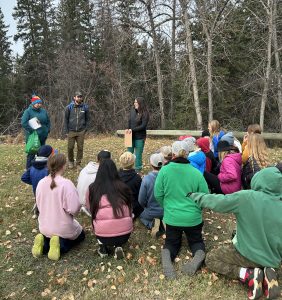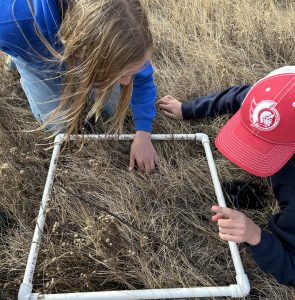November 24, 2023
By Mackenzie Mrazik, Student at University of Alberta Augustana Campus
Though a stranger by no means to the world of youth programming, the Battle River Watershed Alliance has recently developed a new addition to their environmental education field trips. Similar to other programs currently offered by the BRWA such as the Grade 5 Discover Your Wetland field trip and Grade 4 Waste in Our Watershed tour, the new Habitat Tour is based on Grade 6 curriculum. BRWA seeks to give students the opportunity to experience knowledge learned in the classroom come to life in the wild. The tour takes place in the beautiful, ecologically diverse Big Knife Provincial Park and focuses on exploring and observing various habitats while discussing driving forces of environmental change.

Big Knife Provincial Park is an ideal location, and the BRWA has expertly utilized the area when designing the Habitat Tour to create a field trip of high educational value and enjoyment. The Habitat Tour is a guided hike through the park with a total of 5 stops. Each stop occurs at a microhabitat, the stops being aspen forest, coniferous forest, wetlands/freshwater, grasslands, and hoodoos. Grade 6 curriculum links are found throughout the whole tour. This is evident in the intentional discussions and observations of biodiversity within each microhabitat, recognizing invasive/non-native species, and considering the environmental impacts of human activity. Though the outlined talking points of the tour are based on Grade 6 curriculum, the students are also encouraged to ask their own questions and respectfully explore the environment through personal observation. Learning curriculum content is a key component of the tour, but learning new skills is also deeply incorporated into the goals of the program. Students learn how to use binoculars and spot signs of animals, amongst others. Another major aspect of the tour is hands-on activities which combine practicing new skills and learning the course content. The transect squares is a great example of this, where students investigate a small area and search for as many different species as possible. Invasive species tag also demonstrates the tour’s emphasis of both fun and learning by demonstrating the relationship between native and invasive species through an engaging and memorable experience. The Habitat Tour is where the classroom is taken outdoors and engages students through exploration, teaching, and activities.

As an observer of the tour, I saw how the passionate work of the BRWA translates into programs which instill and uncover the same passions in the next generation. The Big Knife Habitat Tour engages with students to create a deeper understanding of the knowledge learned at school by bringing the curriculum to life. Not only this, but the Habitat Tour program also cultivates a deeper understanding of environmental responsibility, and invites students to understand their individual importance in the protection and preservation of the watershed and other ecosystems. After running 2 successful pilot tours this fall, the BRWA looks forward to continuing this interactive and meaningful program with more classes in the spring of 2024.
The Habitat Tour program was developed with sponsorship from Heartland Generation.
Mackenzie is a Community Service Learning student from the University of Alberta Augustana Campus. She is working on her degree in Kinesiology.